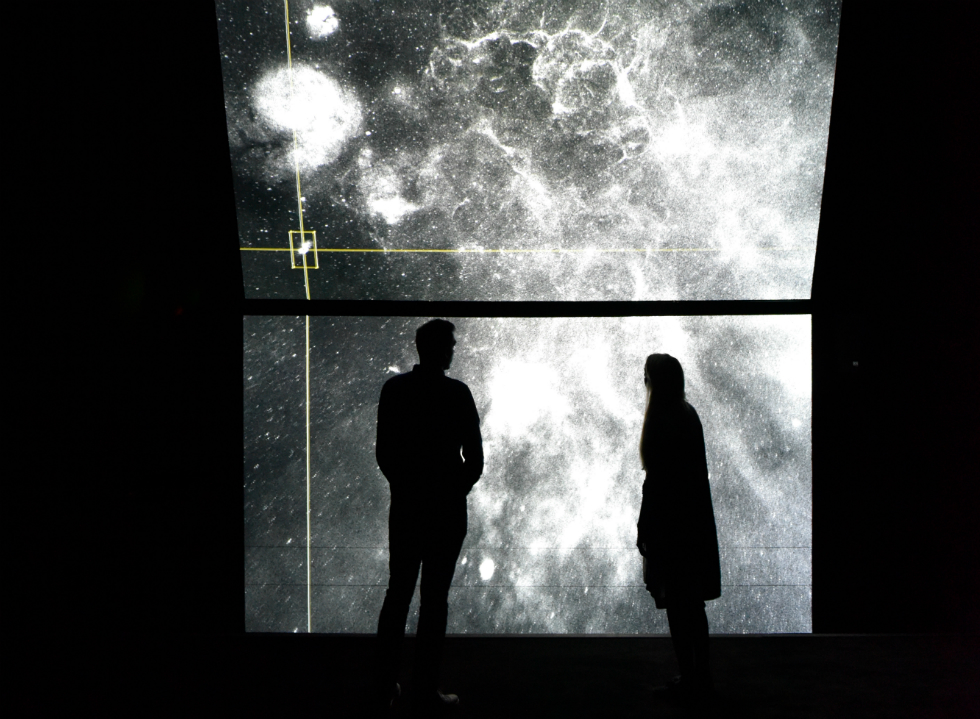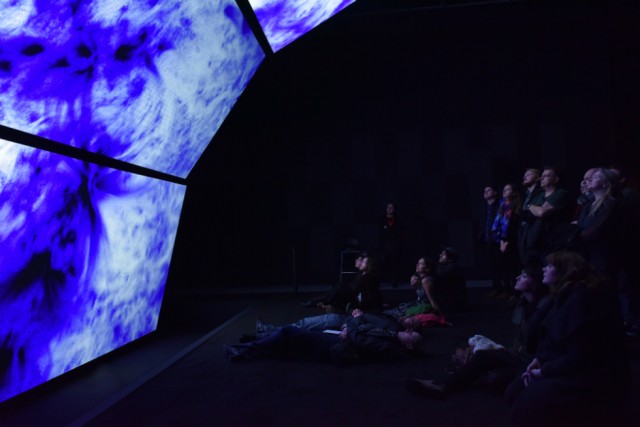“A hypnotic, outer-space experience”: Ryoichi Kurokawa’s unfold — Reviewed

Science and art collide in Ryoichi Kurokawa’s latest exhibition, says Jade French; having created a hypnotic, outer-space experience in Liverpool. Prepare to traverse the intersections of art, technology and the cosmos…
Space: the final frontier…
Did you read that in Patrick Stewart’s voice? I bet you did.
I’m a huge space enthusiast. Like many of us here on Planet Earth, I experience a sense of awe and wonder when looking up at the night sky. Believe me, when affordable, commercial space flights finally happen, I’ll be first in line with my Virgin Galactic space ticket. But for those who would rather keep their feet on the ground, a new exhibition at FACT (Foundation for Art and Creative Technology) provides all the imagined experiences of travelling into space, without leaving the gallery.
unfold, as the exhibition is called, is Japanese artist Ryoichi Kurokawa’s first ever solo show in the UK. Commissioned by FACT and funded through their first Kickstarter campaign, this incredible installation sees Kurokawa use audio-visuals to explore the birth and evolution of our solar system.
Spread across FACT’s two galleries, this exhibition presents a new work in a tandem of forms, as well as musical composition, Syn_, which Kurokawa performed live earlier this month at the Liverpool Philharmonic. And although billed as a solo show, unfold is actually the result of a unique cross-disciplinary collaboration. Kurokawa has worked with Vincent Minier — an astrophysicist at the Institute of Research into the Fundamental Laws of the Universe – to access and interpret scientific data. This data, some of which was collected from NASA’s Herschel Telescope, has been transformed in an unforgettable, immersive and multi-sensory artwork.
But how accurate is this artistic representation of our solar system? Well, pretty darn accurate, actually. Minier’s main field of expertise is star formation and Kurokawa, through this new work, is giving audiences unrivalled scientific access and accuracy. Minier, however, does point out that the colouration is not exactly a precise representation of the hue native to space — this is Kurokawa’s interpretation — but rather the colour represents “a light density, a temperature, or even a chemical composition”.

Entering the ground floor Gallery One — which is so dark that my eyes painfully adjust — I already feel vibrations. The sizeable, dark room is illuminated by three large screens, which to me look like the front windows of a space ship. They show endless black space, illuminated by stars that gently form one constellation. Is this what it’s like to orbit in space? The tranquility doesn’t last long though, as suddenly the floor is shaking, my ears are buzzing, and my imaginary spacecraft is about to jump into Faster Than Light (FTL) drive… The screens burst with colour and flash in sync with the rumbling floors. It’s a hypnotic, outer-space experience. All of my senses are being invaded, and it’s brilliant.
Synaesthesia — hence, we presume, where Syn_ originated — is a condition where a sensation in one of the five senses triggers a sensation in another. This phenomenon is a core element of Kurokawa’s work, and particularly evident in the title piece, unfold. Colour, sound, movement and images work as one, and it’s hard to describe one aspect without the other. In conversation with Kurokawa in the gallery, his advice for engaging with the work was simply: “Just feel”. I completely agree. It’s tricky to translate into words artwork that is completely experiential. It is welcome news, then, that unfold is being accompianied by a substantial public programme over the next two months, coinciding with Light Night Liverpool and British Science Week. A personal highlight would be the screening of sci-fi film Interstellar (2014) on Wednesday 20 April; introduced by Andrew Newsam, Professor of Astronomy Education and Engagement at Liverpool John Moores University, who will be discussing the physics behind the film.
Upstairs at FACT, you’ll find The Wall: a series of eight digital prints showing raw scientific data alongside three-channel audio. Although interesting, as it gives further insight into the actual scientific values, it feels peripheral and somewhat unnecessary in comparison with the main installation. Gallery Two, meanwhile, is entitled constrained surface. Upon entering a dark space, there lie a duo of small HD displays positioned on an angle. The installation, which is around eight minutes long, begins by gently conjuring images of a sunrise on an alien planet, before descending into Kurokawa’s otherworldly brand of chaos. Beautiful and unnerving, just like space.
Whilst seemingly disparate and often polarised, art and science are arguably symbiotic and unfold goes a long way to address this. Art is often seen as creative, intuitive, expressive, sensual, experiential, even emotional; and science as methodical, logical, explicative, intellectual, cognitive. But is this true? I’m not so sure, and Kurokawa doesn’t seem to think so. Both fields are driven to explore the unknown, discover new worlds, and push the boundaries of human limitation; qualities which, whilst widely recognised of our scientists, are certainly true of our artists, too.
Jade French
See unfold at FACT, Liverpool, until 12 June 2016 — FREE. Galleries open Tuesdays-Sundays 1am-6pm
Check out the full programme of public workshops, performances and films coinciding with the exhibition here
Don’t miss: Ryoichi Kurokawa at Sound City 28-29 May 2016 (venue TBC). As a part of the Sound City festival FACT and Sedition have collaborated to create a series of shorts by Kurokawa to be played as an extension of unfold.





